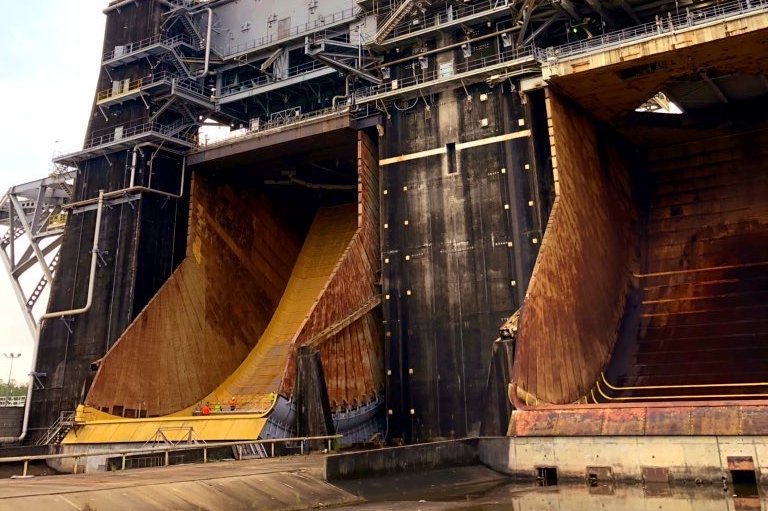1 of 5 | NASA is gearing up to test fire the new SLS moon rocket's core stage at Stennis Space Center in southern Mississippi, where huge flame buckets were being renovated Tuesday to redirect exhaust that is to be cooled by water. Photo by Paul Brinkmann/UPI
STENNIS SPACE CENTER, Miss., Dec. 10 (UPI) -- NASA is preparing to test fire the largest rocket since the Apollo era at the sprawling Stennis Space Center in southern Mississippi, where the new Space Launch System core is expected to arrive in a matter of weeks.
On Tuesday, work crews were putting finishing touches on gigantic steel flame buckets that will catch and redirect exhaust as the rocket engines are fired for more than eight minutes. The preparation reminds many of the excitement that preceded Apollo.
"I was a test engineer for 20 years and always wondered what it would be like to do something like what we did in the '60s," said Maury Vander, now director of operations at Stennis. "Many people told me it will never happen again. Well now I'll be able to say they were wrong."
The rocket's core stage is about 212 feet high -- like a 21-story building. It will be shipped from the Michoud Assembly Facility in New Orleans on NASA's Pegasus barge.
The core is to spend about eight months at Stennis, where it will be set on Test Stand B-2, bolted down and eventually tested in what's called a green run. Tests are run cooperatively between NASA, Boeing and Aerojet Rocketdyne, which makes the engines.
Although Stennis has been busy over the years, Vander said quiet periods have existed, too, especially after the space shuttle program ended in 2011. Now, however, the space agency and private industry are gearing up to bring in 200 to 300 more people for the SLS test.
Facilities that were built in the 1950s for Apollo and refurbished in the 1980s for the shuttle are being upgraded. The 13,800-acre facility is surrounded by a 125,828-acre buffer zone of limited development because of the loud and destructive shock waves that rocket test fires can create.
On Tuesday, crews worked to add a few more holes in the flame buckets to allow a water flow of 335,000 gallons per minute to cool the rocket stand during the SLS test.
Eight minutes represents the length of time SLS rockets will burn to lift off the ground and reach 100 miles high, consuming 200,000 gallons of liquid oxygen and 500,000 of liquid hydrogen -- which are highly reactive and explosive when mixed.
The propellants are mixed in the four main engines, which are the same RS-25 engines built by Aerojet Rocketdyne that were used on the space shuttle orbiter. Sixteen of the engines were left over after the shuttle program ended, two of which have not been used.
In a real flight, the SLS rocket exhaust would only hit the launch pad for a few moments before lifting off. But the rocket will be held in place during the test fire, meaning the superheated flames could warp the test stand if not cooled. So NASA has completely renovated the stand's high-pressure water system.
Once NASA is satisfied the rocket is safe, it will be lifted back onto the Pegasus barge and shipped to Kennedy Space Center in Florida for launch.
The first SLS rocket is to be launched without a crew sometime in 2020. Only this first Artemis-era rocket will be test fired at Stennis, said Boeing's Mark Nappi, director of SLS core stage testing. After that, SLS rockets will be tested in limited fashion at Michoud and again at Kennedy Space Center.
Software models now enable NASA to run virtual tests to determine if anything is wrong. "We will validate all the systems -- avionics, hydraulics, propulsion and so on," Nappi said.
After the stress and pressure of a green run, the rocket will need some two months of refurbishing for the actual launch, Nappi said.
"We will fix any damage that occurred. We suspect we know where some of the damage will be, but we can't expect all of it," he said. "Some of the work will be done here and some will be done at Kennedy Space Center."















